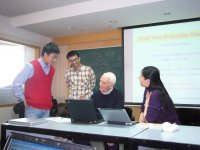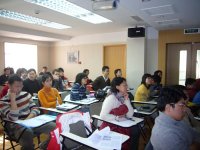 |
 |
|||||||||||||
|
|||||||||||||
|
|||||||||||||
|
From 7 to 11 January, the first school on the Time Projection Chamber (TPC) technology was held at the China Center for Advanced Science and Technology (CCAST) in Beijing. Over 50 students, young scientists and senior researchers from Asia and the rest of the world gathered to learn and discuss about TPC Technology for the International Linear Collider.
A total of 33 universities and laboratories around the world are working on development of TPC, a part of the central tracking system for an ILC detector. Tsinghua University, Beijing, China, joined the LC-TPC (Linear Collider TPC) International collaboration last year. Yuanning Gao of Tsinghua University, who leads the Chinese TPC-related activities, organised this school to raise the younger generation's interest in particle physics and ILC-related detector R&D. “I invited the leading experts on TPC technology from over the world as the speakers so that the Asian young researchers can have wonderful opportunity to learn,” said Gao. Not all the students who participated in this school are involved in ILC detector work yet. “I am sure that the students who attended this school have been inspired, and hopefully they become leading scientists for ILC.” There were a total of about 20 talks over the five-day school. The presentations covered a broad spectrum of issues, from the basics to specifics in order to cater for all the attendees' knowledge level. Topics included the physics of the ILC, the detector concepts, the technical physics related to the TPC, the practical issues of building and operating a TPC including several examples of experience in past collider detectors, and the technology options for the LC-TPC and the R&D being pursued towards choosing the best option for the central tracker-something for everybody. All talks were followed by extended discussions between the interested and excited students for the future ILC physics and detector. Keisuke Fujii of KEK, who gave lectures on basic physics of TPC operations, said: “I felt the enthusiasms of the Chinese students, which is almost a hunger for knowledge. They surely are eager to learn, and did not want to miss any opportunity.” The students only asked questions about physics or detector technology-no chatting about food or weather. Most of the attendees were Chinese, some were from Japan. “We should continuously organise schools like this in different field in different venues, and hope to see same enthusiasm there,” Fujii added. TPC experts, many from Europe, working on ILC physics and detector issues were among the lecturers. Ron Settles from MPI-Munich and spokesman-emeritus of the LC-TPC collaboration, reflected: “Based on experience gained from past collider experiments in America, Asia and Europe, we know the best way to build a detector for the ILC to get the most out of the physics. Yuanning and I worked together at LEP (where we think we caught a glimpse of the Higgs boson) and are convinced that a TPC is an essential part of the ILC detector concept. The acceptance of these ideas by the students at the TPC School was probably more exciting for us than for them.” “This TPC School was a big success, both for the Chinese and for international collaboration,” said Gao. “The ILC is an international project which will take some time to organise. The participation of younger generation is essential for the realisation of the ILC.” -- Rika Takahashi |
|||||||||||||
| © International Linear Collider |

